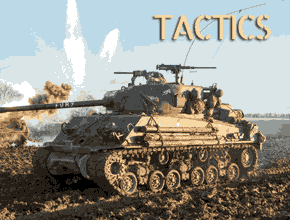The Mk 61 105 mm self-propelled howitzer or was designed and built during the late 1950s for the French Army, based on the mass-produced AMX-13 light tank for commonality. Inspired somewhat by WW2 German self-propelled artillery, it was a well protected (albeit not NBC) vehicle, capable of 60 km/h (37 mph) and with the Obusier de 105 modèle 1950 howitzer capable of a range of 14.5 km (9 mi) at 6 rpm. It was priduced to 550 vehicles at Roanne Workshops and also exported and used by Israel in the 1967 war, but also Indonesia, Morocco and the Netherlands. The improved Mk.62 was developed for Switzerland but not adopted. One was preserved at Thun, another at Saumur. Some sources called it the AMC-105 but it was never official.
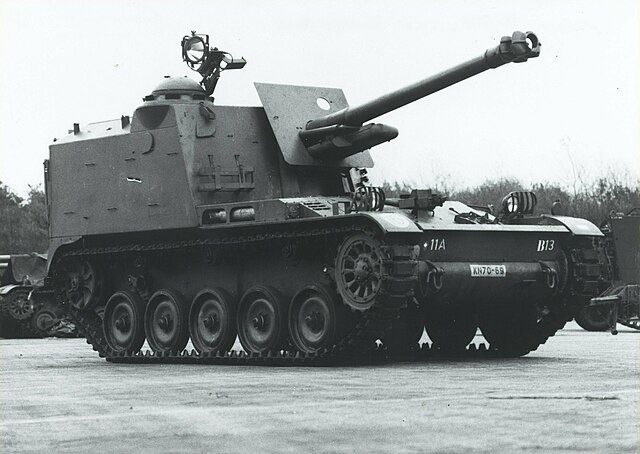
The creation of fast, heavily armed reconnaissance units needed organic fire support. For these fast-paced mechanized divisions based on the new AMX-13 light tank, the chassis was found adequate to decline a range of vehicle. The AMX-13 after all was built to 7700 vehicles, an absolute record for the hexagon. It was declined into several vehicles, a bridgelayer, engineering vehicle, and more importantly an armoured personel carrier (AMX-VCI), an AA vehicles (AMX DCA), and for artillery the F3 155 mm self propelled gun, which was open and unprotected. Another was a well protected self-propelled gun, which imposed a smaller caliber to fit in, the Mk 61, Mk 61 Ob 105 Au 50.
The origin of the program went all the way back to 1946 with a requirement put forth for an air-transportable tank which became the AMX-13, production starting in 1952. It was quickly derived as the “Obusier de 105-mm automoteur, modele 1950” after a 1948 specification (Ob 105 Au 50). It is best known under its factory designation of Mk 61, at Atelier de Construction Roanne. Its core was the new Model 1950 105-mm howitzer, mounted inside a specially designed casemate at the rear. Its own production started just a year after the AMX-13, in 1953. In total 429 were built (other sources states 550, which might include exports) and the line closed in 1958. Chars-Francais states it still underwent tests until 1955, whereas other sources states construction started in 1953. It might include only pre-series and prototypes, with mass production starting effectively in 1955.
337 were absorbed by the French Army to replace the same-caliber M7 105-mm HMC. The different was exported to the Netherlands and entered service in the Dutch Army alongside other AMX family vehicles. The remainder were sold to Israel, and they were available during the 1956 Suez War and fought last in the 1967 Six Day War. When France and the NL started to be retired from service they were resold to Indonesia and Morocco.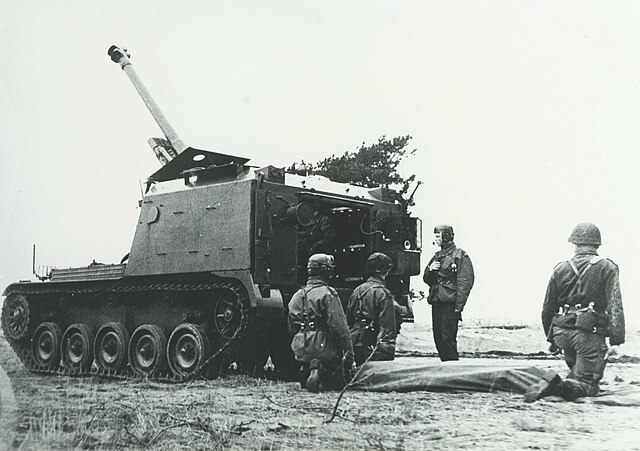
Dutch AMX-PRA in training
We skip the description of the chassis (see the AMX-13 for more) and jump directly to the main difference, the all-welded box-shaped steel structure mounted at the rear. Like the original, which gun turret was also at the rear, the engine compartment was forward. The casemate provide a 360° protection, both from small arms rifle fire and shell splinters, so around 8-12 mm. The chassis was lightly protected just as the AMX-13.
However due to the large opening for the howitzer forward and above, the compartment lacked NBC (nuclear, biological, chemical) protection. The weight of the casemate and howitzer also meant it was not amphibious. The driver was located at the left of the transmission and engine unit, occupying most of the nose. The gun compartment behind was organized around the bulky howitzer's breech and ammunition racks. There was a commander's cupola to the left, with a periscope, and 360° vision blocks plus a ring mount for a roof 7.5 or 7.62 mm light machine gun.

Interior of an AMX PRA, breech.
The loader to the right had an access hatch and there was another, larger two-piece hatch for exit at the rear of the casemate's roof and two access doors on its bacl plate with ejection port. There were also rack to strap gear on both sides. Tooling boxes were located forward, on both sides. The vehicle had two gun ports on the front-top of the casemate's sides, both sides, and six strapping handles. There was also a large antenna mast on the left front plate and spare crowbar, axe, pickaxe, and shovel on both sides.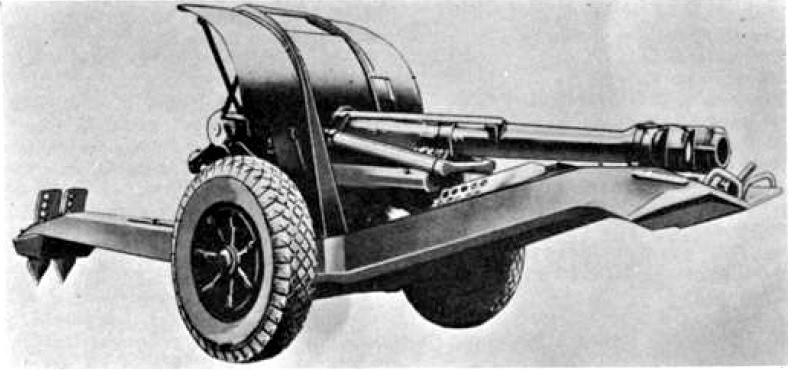
The Obusier de 105 modèle 1950, or 105 mm howitzer model 1950 is 23 calibers ordnance designed and built at the Arsenal de Bourges from 1945. It was the first 105 mm howitzer designed and manufactured in Western Europe postwar and into service, remaining frontline in the French army until 1962 and used notably in the Algerian war. It was adapted with a new cradle designed for the casemate. This howitzer fired the 15 kg (33 lb) Semi-fixed 105x372 mm R 105 mm (4.1 in) caliver shell. It used an Hydro-pneumatic recoil system, and was able to elevate down -4° and up to +66°* with a traverse of 20° right and left.
Rate of fire was 6 rpm, and muzzle velocity 580 m/s (1,900 ft/s), at a max range of 14.5 km (9 mi). The original howitzer on its split trail mount olny elevated to 70° so this was achievement to almost keep the same elevation inside the casemate. The Obus modele 53 was an HE round, without anti-tank properties. The type remained inferior to the US 105 mm M2 howitzer and was not an export success. Only Ivory coast obtained four of these in 1972. In France the original Obusier was sidelined to be used as intruction gun. The same limitations also limited the use of the Mk 61 for a decade.
A single variant was derived from the Obusier de 105-mm automoteur, modele 1950. The Mk 62, for the Swiss army. Thos was an updated variant with longer barrel and a rworked turret to traverse 360° instead of a fixed casemate. It was offered to Switzerland and four were tested by the Swiss military, but not adopted. One was preserved at the tank museum in Thun, others ended in private collections, notably in the US. One Mk 61 was also seen on sale at Sothebys.
 French Army: 337 used in the Algerian war 1955-62. Retired in 1969.
French Army: 337 used in the Algerian war 1955-62. Retired in 1969.
 IDF: 60 delivered in 1955. Took part in the Suez intervention in 1956.
IDF: 60 delivered in 1955. Took part in the Suez intervention in 1956.
 N. Royal Army, 82 AMX-PRAs assigned to the artillery from 1965 to 1984.
N. Royal Army, 82 AMX-PRAs assigned to the artillery from 1965 to 1984.
 Moroccan Royal Army, 45 delivered, second hand French in the 1970s.
Moroccan Royal Army, 45 delivered, second hand French in the 1970s.
 Indonesian Army: 4 delivered, in service in the late 1990s.
Indonesian Army: 4 delivered, in service in the late 1990s.
 Switzerland: Four AMX-105B (Mk 62) delivered for evaluations.
Switzerland: Four AMX-105B (Mk 62) delivered for evaluations.

Development
World War II self-propelled artillery was found useful in many late operations, bringing support and seeing the use of frontline, armored assault guns protected from all angles or with lightly protected open topped tank-destroyers. Chassis could be based on existing vehicles to gain time in development. In WW2 Free France received a number of US built M7 Priest as well as M12 gun motor carriage (GMC) for its own operations in Alsace-Lorraine and in south Germany. By the 1950s a new rearmament planned to replace both units, alongside the new doctrine placing mobililty above all else.The creation of fast, heavily armed reconnaissance units needed organic fire support. For these fast-paced mechanized divisions based on the new AMX-13 light tank, the chassis was found adequate to decline a range of vehicle. The AMX-13 after all was built to 7700 vehicles, an absolute record for the hexagon. It was declined into several vehicles, a bridgelayer, engineering vehicle, and more importantly an armoured personel carrier (AMX-VCI), an AA vehicles (AMX DCA), and for artillery the F3 155 mm self propelled gun, which was open and unprotected. Another was a well protected self-propelled gun, which imposed a smaller caliber to fit in, the Mk 61, Mk 61 Ob 105 Au 50.
The origin of the program went all the way back to 1946 with a requirement put forth for an air-transportable tank which became the AMX-13, production starting in 1952. It was quickly derived as the “Obusier de 105-mm automoteur, modele 1950” after a 1948 specification (Ob 105 Au 50). It is best known under its factory designation of Mk 61, at Atelier de Construction Roanne. Its core was the new Model 1950 105-mm howitzer, mounted inside a specially designed casemate at the rear. Its own production started just a year after the AMX-13, in 1953. In total 429 were built (other sources states 550, which might include exports) and the line closed in 1958. Chars-Francais states it still underwent tests until 1955, whereas other sources states construction started in 1953. It might include only pre-series and prototypes, with mass production starting effectively in 1955.
337 were absorbed by the French Army to replace the same-caliber M7 105-mm HMC. The different was exported to the Netherlands and entered service in the Dutch Army alongside other AMX family vehicles. The remainder were sold to Israel, and they were available during the 1956 Suez War and fought last in the 1967 Six Day War. When France and the NL started to be retired from service they were resold to Indonesia and Morocco.
Hull and general design

Dutch AMX-PRA in training
We skip the description of the chassis (see the AMX-13 for more) and jump directly to the main difference, the all-welded box-shaped steel structure mounted at the rear. Like the original, which gun turret was also at the rear, the engine compartment was forward. The casemate provide a 360° protection, both from small arms rifle fire and shell splinters, so around 8-12 mm. The chassis was lightly protected just as the AMX-13.
However due to the large opening for the howitzer forward and above, the compartment lacked NBC (nuclear, biological, chemical) protection. The weight of the casemate and howitzer also meant it was not amphibious. The driver was located at the left of the transmission and engine unit, occupying most of the nose. The gun compartment behind was organized around the bulky howitzer's breech and ammunition racks. There was a commander's cupola to the left, with a periscope, and 360° vision blocks plus a ring mount for a roof 7.5 or 7.62 mm light machine gun.

Interior of an AMX PRA, breech.
The loader to the right had an access hatch and there was another, larger two-piece hatch for exit at the rear of the casemate's roof and two access doors on its bacl plate with ejection port. There were also rack to strap gear on both sides. Tooling boxes were located forward, on both sides. The vehicle had two gun ports on the front-top of the casemate's sides, both sides, and six strapping handles. There was also a large antenna mast on the left front plate and spare crowbar, axe, pickaxe, and shovel on both sides.
Powerplant and performances
The new vehicle had the same powerplant as the original AMX-13, a SOFAM Model 8Gxb 8-cylinder, gasoline rated for 250-hp. Thanks to this and the light chassis, with a Power to weight ratio of 13.8-hp/ton, the Mk 61 could reach 60 kph (39 mph) on flat. Range was 220 km also on road. The drivetrain comprised five-wheeled torsion bar suspension, front drive sprocket, rear idler, three return rollers. All wheels were rimmed in solid rubber whereas the metallic tracks had optional rubber pads or traction blocks depending of the traction needed and to reduce vibrations on road.Armament

The Obusier de 105 modèle 1950, or 105 mm howitzer model 1950 is 23 calibers ordnance designed and built at the Arsenal de Bourges from 1945. It was the first 105 mm howitzer designed and manufactured in Western Europe postwar and into service, remaining frontline in the French army until 1962 and used notably in the Algerian war. It was adapted with a new cradle designed for the casemate. This howitzer fired the 15 kg (33 lb) Semi-fixed 105x372 mm R 105 mm (4.1 in) caliver shell. It used an Hydro-pneumatic recoil system, and was able to elevate down -4° and up to +66°* with a traverse of 20° right and left.
Rate of fire was 6 rpm, and muzzle velocity 580 m/s (1,900 ft/s), at a max range of 14.5 km (9 mi). The original howitzer on its split trail mount olny elevated to 70° so this was achievement to almost keep the same elevation inside the casemate. The Obus modele 53 was an HE round, without anti-tank properties. The type remained inferior to the US 105 mm M2 howitzer and was not an export success. Only Ivory coast obtained four of these in 1972. In France the original Obusier was sidelined to be used as intruction gun. The same limitations also limited the use of the Mk 61 for a decade.
Variants and Users

A single variant was derived from the Obusier de 105-mm automoteur, modele 1950. The Mk 62, for the Swiss army. Thos was an updated variant with longer barrel and a rworked turret to traverse 360° instead of a fixed casemate. It was offered to Switzerland and four were tested by the Swiss military, but not adopted. One was preserved at the tank museum in Thun, others ended in private collections, notably in the US. One Mk 61 was also seen on sale at Sothebys.
 French Army: 337 used in the Algerian war 1955-62. Retired in 1969.
French Army: 337 used in the Algerian war 1955-62. Retired in 1969. IDF: 60 delivered in 1955. Took part in the Suez intervention in 1956.
IDF: 60 delivered in 1955. Took part in the Suez intervention in 1956. N. Royal Army, 82 AMX-PRAs assigned to the artillery from 1965 to 1984.
N. Royal Army, 82 AMX-PRAs assigned to the artillery from 1965 to 1984. Moroccan Royal Army, 45 delivered, second hand French in the 1970s.
Moroccan Royal Army, 45 delivered, second hand French in the 1970s. Indonesian Army: 4 delivered, in service in the late 1990s.
Indonesian Army: 4 delivered, in service in the late 1990s. Switzerland: Four AMX-105B (Mk 62) delivered for evaluations.
Switzerland: Four AMX-105B (Mk 62) delivered for evaluations.
Mk 61 105 mm SPH specifications | |
| Dimensions (l-w-h): | 6.4 x 2.6 x 3.1 m (21 x 8 ft 6 in x 8 ft 10 in) |
| Total weight: | 16,500 kg (36,400 lb) |
| Crew : | 5 |
| Propulsion: | SOFAM 8Gxb 8-cyl. WCL 250 hp (190 kW) 15 hp/tonne |
| Suspensions: | Torsion bar |
| Top Speed | 60 km/h (37 mph) |
| Range (flat) | 349 km (217 mi) |
| Armament | 105 mm howitzer, 7.62 mm LMG ring mount |
| Armour | Steel, 13 mm front |
| Total Production | 550 |
Gallery
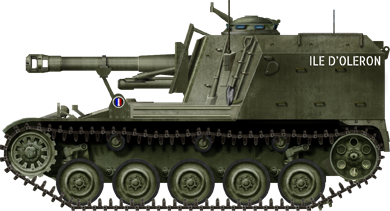
French Vehicle in 1959
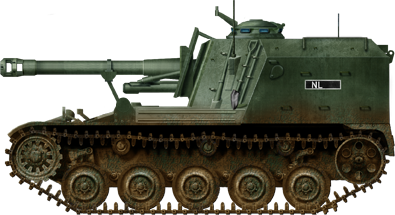
Royal Netherlands Army PRA-105 1967
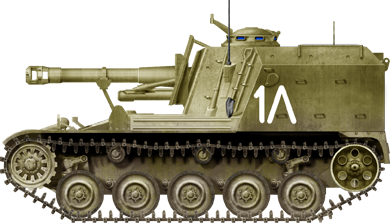
Mk.61 of the IDF, 6 days war Sinai, 1967
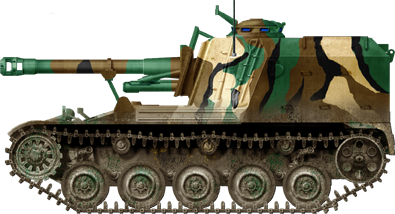
Indonesian Mk.61 in the 1980s
Preserved at Saumur museum
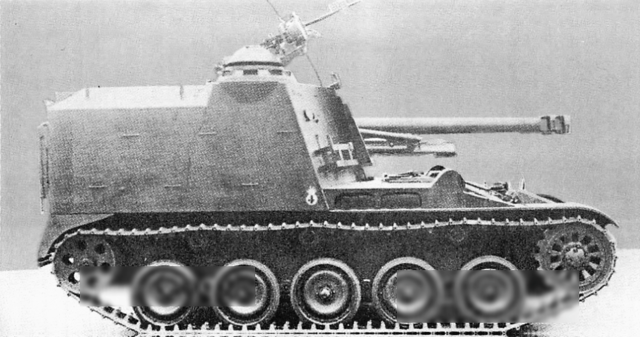
Short barrel prototype
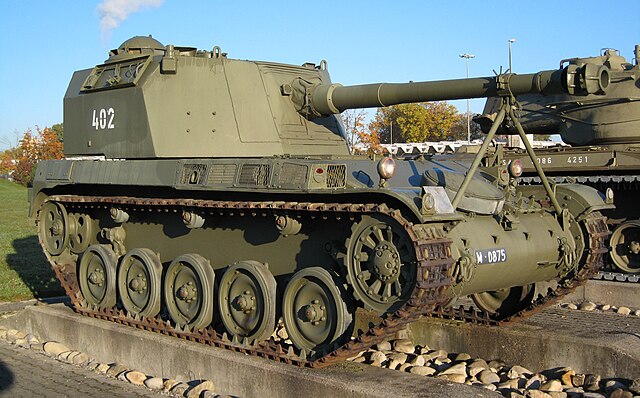
Swiss Panzerhaubitze AMX-13, preserved at Thun
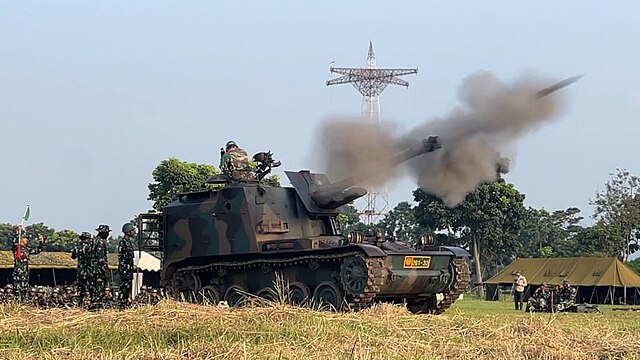
Indonesian Mk.61 firing

IDF vehicle in 1963

IDF vehicles at the Independence Day parade, Haifa 1957.

Dutch PRA "calimero" preserved at Overloon
Links
chars-francais.net (archive)chars-francais.net (actual)
militaryfactory.com
weaponsystems.net
cc photos
armedconflicts.com
aminoapps.com
Kit on 1999.co.jp
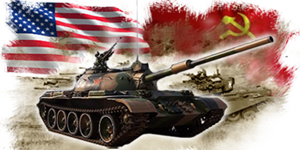
Cold War Tanks


































Cold war tanks posters

Cold War Main Battle Tanks
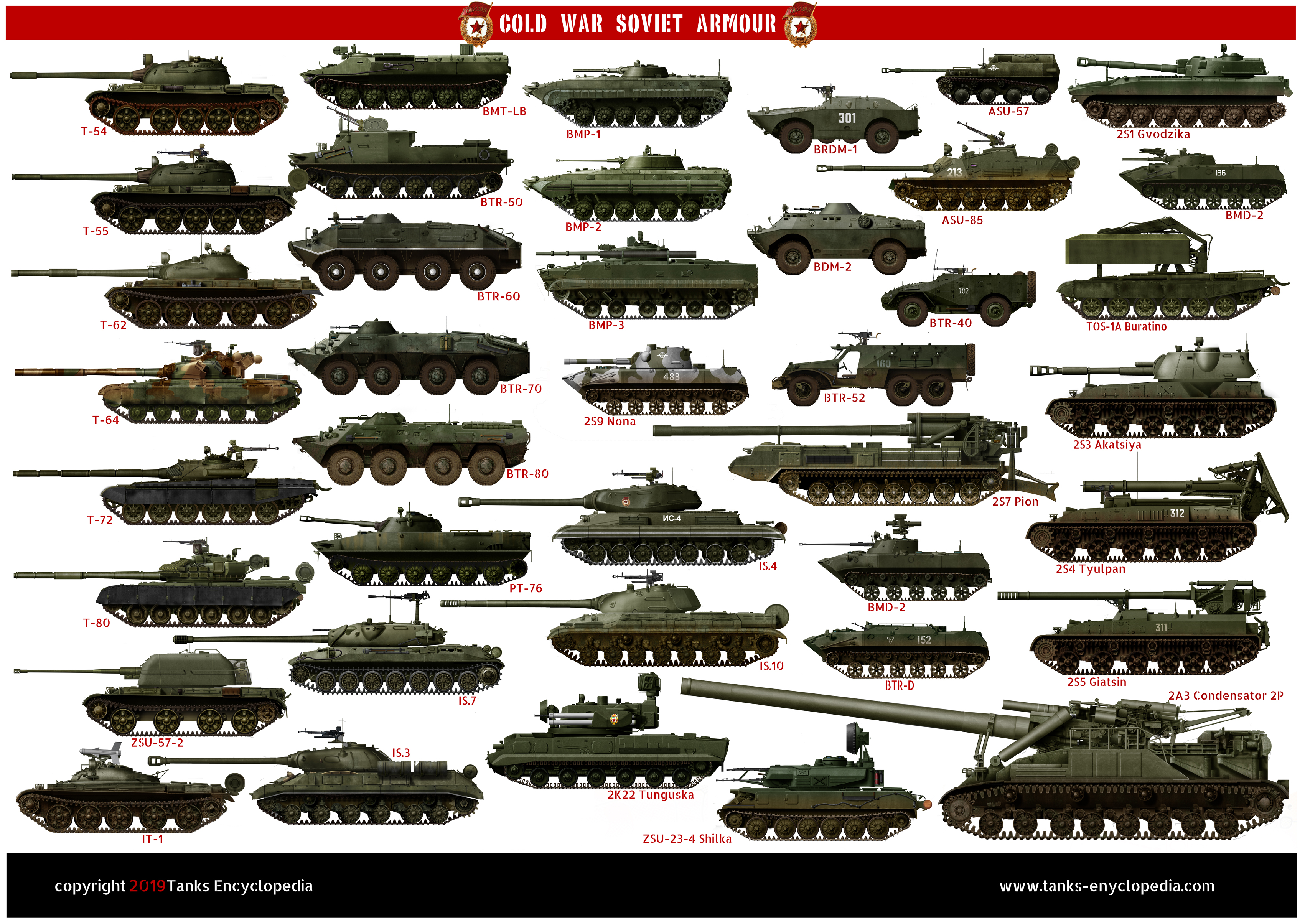
Cold War Soviet Army
Museums, Movies, Books & Games
The Tanks and Armor in pop culture
Tanks and armored vehicles in general are only really grasped when seen first person: The mass, the scale, it's all there. Explore also the way tanks were covered in the movie industry, in books and in video games.Movies:
Best tanks movie on warhistoryonline.com
On imdb.com
On bestsimilar.com/
miltours.com
liveabout.com/
watchmojo.com
Video Games:
pcgamesn.com
historyhit.com
levvvel.com
vg247.com/best-tank-games
mmobomb.com/
alienwarearena.com
